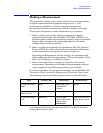
Chapter 1 27
Getting Started
Front Panel Description
9. Probe Power The probe power input supplies power for external
probes; the three connectors are a ground, and a +15 V,
and a
−12.6 V connector. The probe power supplies
power to high frequency probes and accessories, such as
preamplifiers, that are used as accessories to the
transmitter tester. The probe power provides a
maximum of 150 mA.
10. RF Input The 50
Ω RF input allows for input of an external RF
signal. The connector is a type N female, and is rated
for a maximum input of +35 dBm for measuring a CW
signal, and a maximum of 26 volts for a DC signal.
11. Data Entry keys are used to enter numeric values. Entries made
using data entry keys will be visible in the active
function area (see the section on annotation on page 33
to locate the active function area).
• The
Enter key is used to terminate numeric data
where no units of measurement are being entered, or
where you want to terminate with the default unit of
measurement. For operations involving selection of a
unit of measurement (for example, dB, dBm,
Hz, s, degrees, radians), the
Units softkey menu
(explained below) is used to terminate numeric
entries.
•
Units softkeys are used to enter units of
measurement. If the value you are entering is in
units of measurement, the units softkey menu will
automatically appear once you enter a digit. After
entering the desired numeric value, you terminate
the entry by pressing the appropriate units of
measurement softkey.
•
Numeric keys enter numeric values as indicated on
the keys. In addition, decimal and positive and
negative sign keys are available for your use.
• The
Step keys (these are the up and down arrow
keys) change numeric values in increments of the
current step size.
• The
Backspace key moves the cursor backwards one
space and erases the character in that space. You
can use the
Backspace key to backspace characters in
the active function area.
• The RPG Knob changes numeric values in
increments of the current knob resolution.


















